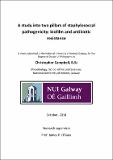| dc.description.abstract | Biofilm formation on inserted medical devices by the opportunistic pathogen, Staphylococcus epidermidis, continues to be constant threat in clinical health-care settings. Once established, biofilms are almost impossible to treat therapeutically, resulting in the need to remove and replace the device. In cases where a device cannot be easily replaced, such as artificial joints or prosthetic heart valves, surgical intervention is often the last resort. As a leading cause of nosocomial infections, S. epidermidis biofilm formation has been the subject of much research. The ica operon is responsible for synthesising polysaccharide intercellular adhesion (PIA) / poly-N-acetylglucosamine (PNAG), the primary composite of S. epidermidis biofilm. In Staphylococcus aureus, the transcription factor, Rbf, has been found to regulate ica expression indirectly via a second regulator, SarX. Despite being closely related, we show that in S. epidermidis, Rbf regulates ica expression via a second member of the Sar family of transcription factors, SarR. We propose a novel regulatory pathway consisting of two negative regulators, Rbf and SarR, under conditions of osmotic stress. This data provides an insight into how S. epidermidis copes with osmotically challenging conditions on human skin, and potentially aid in therapeutic design in the future.
The tricarboxylic acid (TCA) cycle is an important source of energy and metabolic intermediates for S. aureus. To survive β-lactam exposure the cell requires increased peptidoglycan synthesis, and increased TCA cycle activity has been reported in homogenously-resistant MRSA strains. We have identified a single enzyme within the TCA cycle that when disrupted, dramatically decreases oxacillin resistance. Succinyl-CoA synthetase converts succinyl-CoA into succinate in the TCA cycle, and transposon mutagenesis of either of its catalytic subunits increases sensitivity to oxacillin. This phenotype appears to be independent of an altered growth phenotype and colony morphology. We suspect that an accumulation of succinyl-CoA, caused by blockage of the TCA cycle at this juncture may be having post-translational effects on enzymes involved in cell wall synthesis, thereby reducing the cells ability to resist β-lactam antibiotics. Lysine-succinylation has been recently implicated in modifying proteins in several other pathogenic organisms, but to date has not been characterised in S. aureus. The prospect of over-succinylating peptidoglycan-biosynthesis proteins and thereby sensitising MRSA to β-lactams, could make succinyl-CoA synthetase an attractive target for novel therapeutics.
Purine metabolism has been shown to play an important role in modulating β-lactam resistance. Mutations in both the purine de novo and salvage pathways have been associated with the emergence of high-level, homogenously-resistant MRSA strains. A common element noted in the literature is the overall reduction in GTP levels within the cell, either through the synthesis of the stringent response alarmone, ppGpp, using GTP as a substrate, or via mutations in various enzymes in the biosynthetic pathways such as HprT and GuaB. In a screen of the Nebraska Transposon Mutant Library (NTML) we have identified two genes encoding for elements of the purine salvage pathway that when mutated via transposon insertion, exhibit increased resistance to oxacillin. deoD encodes a purine nucleoside phosphorylase, and nupG encodes a guanosine permease. Both mutants displayed decreased levels of intracellular GTP, similar to the response found during amino acid starvation. Although the link between reduced purine metabolism and increased β-lactam resistance has not been fully elucidated, our data both complements existing literature and adds two new elements to this area of research. | en_IE |


